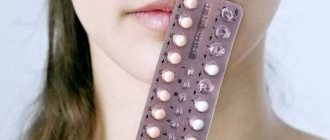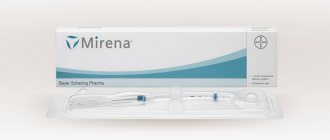Compound
| Film-coated tablets of different colors | 1 blister |
| Dark yellow film-coated tablets | 1 table |
| core | |
| active ingredient: | |
| estradiol valerate, micro 20 | 3 mg |
| excipients: lactose monohydrate - 48.36 mg; corn starch - 14.4 mg; pregelatinized corn starch - 9.6 mg; povidone 25 - 4 mg; magnesium stearate - 0.64 mg | |
| shell: hypromellose - 1.5168 mg; macrogol 6000 - 0.3036 mg; talc - 0.3036 mg; titanium dioxide - 0.584 mg; iron oxide yellow dye - 0.292 mg | |
| Pink film-coated tablets | 1 table |
| core | |
| active components: | |
| estradiol valerate, micro 20 | 2 mg |
| dienogest, micro (in terms of 100% substance) | 2 mg |
| excipients: lactose monohydrate - 47.36 mg; corn starch - 14.4 mg; pregelatinized corn starch - 9.6 mg; povidone 25 - 4 mg; magnesium stearate - 0.64 mg | |
| shell: hypromellose - 1.5168 mg; macrogol 6000 - 0.3036 mg; talc - 0.3036 mg; titanium dioxide - 0.83694 mg; red iron oxide dye - 0.03906 mg | |
| Pale yellow film-coated tablets | 1 table |
| core | |
| active components: | |
| estradiol valerate, micro 20 | 2 mg |
| dienogest, micro | 3 mg |
| excipients: lactose monohydrate - 46.36 mg; corn starch - 14.4 mg; pregelatinized corn starch - 9.6 mg; povidone 25 - 4 mg; magnesium stearate - 0.64 mg | |
| shell: hypromellose - 1.5168 mg; macrogol 6000 - 0.3036 mg; talc - 0.3036 mg; titanium dioxide - 0.89694 mg; iron oxide yellow dye - 0.03906 mg | |
| Red film-coated tablets | 1 table |
| core | |
| active components: | |
| estradiol valerate, micro 20 | 1 mg |
| excipients: lactose monohydrate - 50.36 mg; corn starch - 14.4 mg; pregelatinized corn starch - 9.6 mg; povidone 25 - 4 mg; magnesium stearate - 0.64 mg | |
| shell: hypromellose - 1.5168 mg; macrogol 6000 - 0.3036 mg; talc - 0.3036 mg; titanium dioxide - 0.5109 mg; red iron oxide dye - 0.3651 mg | |
| White film-coated tablets (placebo) | 1 table |
| core | |
| excipients: lactose monohydrate - 52.1455 mg; corn starch - 24 mg; povidone 25 - 3.0545 mg; magnesium stearate - 0.8 mg | |
| shell: hypromellose - 1.0112 mg; talc - 0.2024 mg; titanium dioxide - 0.7864 mg |
Description of the dosage form
Dark yellow tablets: round, biconvex, dark yellow film-coated tablets, engraved with “DD” in a regular hexagon on one side. Cross-sectional appearance of the tablets: the core is white to almost white, the shell is dark yellow.
Pink tablets: round, biconvex, pink film-coated, with “DJ” engraved in a regular hexagon on one side. Cross-sectional appearance of the tablets: the core is white to almost white, the shell is pink.
Pale yellow tablets: round, biconvex, pale yellow film-coated tablets, debossed with “DH” in a regular hexagon on one side. Appearance of the tablets in a cross section: the core is white to almost white, the shell is pale yellow.
Red tablets: round, biconvex, red film-coated tablets, engraved with “DN” in a regular hexagon on one side. Cross-sectional appearance of the tablets: the core is white to almost white, the shell is red.
White tablets (placebo): round, biconvex, white film-coated tablets, with “DT” engraved in a regular hexagon on one side. Cross-sectional appearance of the tablets: the core is white to almost white, the shell is white.
special instructions
The transition from Qlaira to the ring should take place after consultation with a gynecologist, since the amount of hormone in the ring is significantly less than what is contained in the tablets. In contrast, the body may not notice a small dose, as a result of which ovulation will occur unhindered.
After changing the type of contraceptive, even from one form of tablet to another, in the first 9 days of using the new product, it is strongly recommended to additionally protect yourself using a barrier method.
Pharmacodynamics
The contraceptive effect of combined oral contraceptives (COCs) is based on the interaction of various factors, the most important of which are suppression of ovulation and changes in the properties of cervical mucus. Along with the prevention of unwanted pregnancy, COCs have a number of positive properties, which, when taking into account also the negative properties (see “Special instructions”, “Side effects”), can help in choosing the most suitable method of contraception. In women taking COCs, the pain and intensity of menstrual bleeding decreases, resulting in a reduced risk of iron deficiency anemia. In addition, there is evidence of a reduced risk of endometrial and ovarian cancer.
The drug Qlaira® has a beneficial effect on the endometrium, which can be used for the treatment of heavy and/or prolonged menstrual bleeding without organic pathology. These symptoms are sometimes referred to as dysfunctional uterine bleeding. The effectiveness and safety of estradiol valerate/dienogest tablets in the treatment of symptoms of dysfunctional uterine bleeding were studied in two double-blind, placebo-controlled clinical trials. Both studies had identical designs and analysis plans. A total of 269 patients were randomized to receive Qlaira® and 152 patients to receive placebo. Both studies showed that Qlaira® was more effective than placebo for treating symptoms of dysfunctional uterine bleeding, with the Qlaira® response endpoint being greater than 40% (95% CI included 50% value) in both studies (p <0.0001). In addition, both studies demonstrated a clinically and statistically significant reduction in menstrual blood loss. This was accompanied by a statistically significant improvement in iron metabolism parameters (hemoglobin, hematocrit and ferritin).
The estrogen in Qlaira® is estradiol valerate, a precursor of natural human 17β-estradiol (1 mg estradiol valerate corresponds to 0.76 mg 17β-estradiol). The estrogen component used in this PDA is therefore different from the estrogens commonly used in PDAs, which are the synthetic estrogens ethinyl estradiol or its precursor mestranol, both containing an ethynyl group at position 17α. This group provides higher metabolic stability, but also a more pronounced effect on the liver.
Taking Qlaira® leads to a less pronounced effect on the liver compared to triphasic COCs containing ethinyl estradiol and levonorgestrel. The effect on sex hormone binding globulin (SHBG) concentrations and hemostatic parameters has been shown to be less pronounced. In combination with dienogest, estradiol valerate demonstrates an increase in HDL cholesterol, while LDL cholesterol concentrations are slightly reduced.
Dienogest is an orally active progestogen that is characterized by additional partial antiandrogenic effects. Its estrogenic, antiestrogenic and androgenic properties are negligible. Thanks to the special chemical structure, a spectrum of pharmacological action is provided that combines the most important advantages of 19-nor-progestogens and progesterone derivatives.
Preclinical data obtained from routine repeated dose toxicity, genotoxicity, carcinogenic potential and reproductive toxicity studies do not indicate a specific risk to humans. However, it should be borne in mind that sex hormones can stimulate the growth of a number of hormone-dependent tissues and tumors. When used correctly, the Pearl index (an indicator reflecting the frequency of pregnancy in 100 women during a year of using a contraceptive) is less than 1. If pills are missed or used incorrectly, the Pearl index may increase.
Analogues of Qlaira
Level 4 ATX code matches:
Trisequence
Silhouette
Angelique
Divina
Klaira birth control pills have analogues, including:
- Pharmatex;
- Escapelle;
- Nonoxylol;
- Tri-Regol;
- Noretin;
- Diana-35;
- Gynepristone (used as emergency contraception);
- Nuvaring hormonal ring ;
- Benatex (prescribed as a contraceptive after abortion, childbirth, in the presence of contraindications to the use of other contraceptives, as well as during breastfeeding);
- Erotex (used for local contraception in women of reproductive age);
- Jess;
- Microgynon;
- Lindinet 20;
- Decasol;
- Mirena;
- Logest;
- Yarina;
- Novinet;
- Marvelon;
- Regulon;
- Jeannine;
- Lactinet;
- Charosetta;
- Femoden.
Pharmacokinetics
Dienogest
Absorption. After oral administration, dienogest is rapidly and almost completely absorbed. Serum Cmax of 90.5 ng/ml is achieved approximately 1 hour after oral administration of a Qlaira® tablet containing 2 mg estradiol valerate + 3 mg dienogest. Bioavailability is about 91%. The pharmacokinetics of dienogest in the dose range from 1 to 8 mg is characterized by dose dependence.
Simultaneous food intake does not have a clinically significant effect on the rate and degree of absorption of dienogest.
Distribution. A relatively large (10%) portion of circulating dienogest is unbound, while about 90% is nonspecifically bound to albumin. Dienogest does not bind to SHBG or corticosteroid binding globulin (CBG). For this reason, there is no possibility of displacing testosterone from its connection with SHBG or cortisol from its connection with DRG. Any effect on the physiological processes of transport of endogenous steroids is therefore unlikely. The Vd of dienogest at steady state concentration is 46 L after intravenous administration of 85 μg of tritium-labeled dienogest.
Metabolism. Dienogest is almost completely metabolized, in accordance with the known metabolic pathways of steroid hormones (hydroxylation, conjugation), with the formation of predominantly hormonally inactive metabolites. Metabolites are eliminated very quickly, so that the predominant fraction in the blood plasma is unchanged dienogest.
The total clearance after intravenous administration of tritium-labeled dienogest is 5.1 l/h.
Elimination. T1/2 of dienogest from blood plasma is approximately 11 hours. After oral administration at a dose of 0.1 mg/kg, dienogest is excreted in the form of metabolites, which are excreted by the kidneys and through the intestines in a ratio of approximately 3:1. After oral administration, 42% of the dose is eliminated within the first 24 hours, and 63% is eliminated within 6 days by renal excretion. After 6 days, a total of 86% of the dose is excreted by the kidneys and intestines.
Equilibrium concentration. The pharmacokinetics of dienogest does not depend on the concentration of SHBG. Css is achieved after 3 days of taking the same dose of 3 mg dienogest in combination with 2 mg estradiol valerate. Cmin, Cmax and the average concentration of dienogest in the blood serum at steady state are 11.8, respectively; 82.9 and 33.7 ng/ml. The average accumulation coefficient for AUC0–24 h is 1.24.
Estradiol valerate
Absorption. After oral administration of estradiol valerate, it is quickly and completely absorbed. Cleavage into estradiol and valeric acid occurs during absorption in the gastrointestinal mucosa or during the first passage through the liver, resulting in the formation of estradiol and its metabolites - estrone and estriol. Cmax of estradiol in the blood serum, equal to 70.6 pg/ml, is achieved between 1.5 and 12 hours after a single oral dose of a tablet containing 3 mg of estradiol valerate on the 1st day of the course. Concomitant food intake does not have a clinically significant effect on the rate and extent of absorption of estradiol valerate.
Metabolism. Valeric acid is metabolized very quickly. After oral administration, approximately 3% of the dose becomes directly bioavailable as estradiol. Estradiol undergoes an intense first pass effect through the liver, and a significant part of the administered dose is metabolized in the gastrointestinal mucosa. Combined with first-pass metabolism in the liver, approximately 95% of an ingested dose is metabolized before entering the systemic circulation. The main metabolites are estrone, estrone sulfate and estrone glucuronide.
Distribution. In blood serum, 38% of estradiol is bound to SHBG, 60% to albumin, and 2–3% circulates unbound. Estradiol may slightly increase serum SHBG concentrations; this effect is dose dependent. On day 21 of the dosing cycle, the SHBG concentration was approximately 148% of baseline, and by day 28 (completion of the inactive tablet phase) it had decreased to approximately 141% of baseline. Apparent Vd after intravenous administration is 1.2 l/kg.
Elimination. Due to the large circulating pool of estrogen sulfates and glucuronides, as well as enterohepatic recirculation, T1/2 of estradiol in the terminal phase after oral administration is a complex parameter that depends on all these processes and is in the range of about 13-20 hours.
Estradiol and its metabolites are excreted mainly by the kidneys, with about 10% excreted through the intestines.
Equilibrium concentration. The pharmacokinetics of estradiol is affected by the concentration of SHBG. In women, the measured concentration of estradiol in blood plasma is the combination of endogenous estradiol and estradiol received while taking Qlaira®. During the phase of taking tablets containing 2 mg estradiol valerate + 3 mg dienogest, the Cmax and average concentration of estradiol in the blood serum at steady state are 66.0 and 51.6 pg/ml, respectively. Throughout the entire 28-day cycle, stable estradiol Cmin was maintained in the range from 28.7 to 64.7 pg/ml.
Reviews about Klaira
Reviews from doctors about Qlaira indicate the high contraceptive effect that the drug has on women. Experts agree that this drug perfectly protects against unplanned pregnancy and at the same time has a positive effect on the health of the female body as a whole.
Reviews about Qlaira birth control pills are generally varied. Some women claim that taking the drug had an effective effect without the side effects of Qlaira; others experienced side effects, but they were short-lived.
Those who took hormonal pills left reviews about Claira on the forums and most of the reviews were positive or neutral. Women who have used a contraceptive for endometriosis speak especially well of the drug. They claim that specific symptoms disappeared after regularly taking birth control pills. However, the duration of taking the drug is different in all cases.
Contraindications
Qlaira® should not be used if any of the conditions listed below are present. The drug should be discontinued immediately if any of these conditions develop for the first time while taking it:
hypersensitivity to the active substances or any of the excipients;
thrombosis (venous and arterial) and thromboembolism currently or in history (including deep vein thrombosis (DVT), pulmonary embolism (PE), myocardial infarction (MI), stroke currently or in history);
conditions preceding thrombosis (including transient ischemic attacks, angina) currently or in history;
identified acquired or hereditary predisposition to venous or arterial thrombosis, including resistance to activated protein C, antithrombin III deficiency, protein C deficiency, protein S deficiency, hyperhomocysteinemia, antibodies to phospholipids (anticardiolipin antibodies, lupus anticoagulant);
presence of a high risk of venous or arterial thrombosis (see “Special Instructions”);
migraine with focal neurological symptoms, incl. in the anamnesis;
diabetes mellitus with vascular complications;
pancreatitis with severe hypertriglyceridemia currently or in history;
liver failure and severe liver diseases (until normalization of liver function indicators);
liver tumors (benign and malignant) currently or in history;
identified hormone-dependent malignant tumors (including genital organs or mammary glands) or suspicion of them;
bleeding from the vagina of unknown origin;
pregnancy or suspicion of it;
breastfeeding period;
lactose intolerance, lactase deficiency, glucose-galactose malabsorption.
WITH CAUTION
If any of the diseases/conditions/risk factors listed below currently exist, then the potential risk and expected benefits of using Qlaira® should be carefully weighed in each individual case:
risk factors for the development of thrombosis and thromboembolism (smoking; obesity; dyslipoproteinemia; arterial hypertension; migraine; heart valve disease; cardiac arrhythmia; extensive surgical interventions without prolonged immobilization);
other diseases in which peripheral circulatory disorders may occur (diabetes mellitus, systemic lupus erythematosus, hemolytic-uremic syndrome, Crohn's disease and ulcerative colitis, sickle cell anemia);
hereditary angioedema;
hypertriglyceridemia;
diseases that first appeared or worsened during pregnancy or against the background of previous use of sex hormones (for example, cholestatic jaundice, cholestatic itching, cholelithiasis, otosclerosis with hearing impairment, porphyria, herpes of pregnant women, Sydenham's chorea);
postpartum period.
Use during pregnancy and breastfeeding
Taking Qlaira® is contraindicated during pregnancy. If pregnancy occurs while using the drug Qlaira®, further use must be discontinued. However, large-scale epidemiological studies have not shown an increased risk of birth defects in children born to women who used COCs before pregnancy, nor have there been any teratogenic effects of COCs from accidental use early in pregnancy.
COCs can affect lactation because they can reduce the volume of breast milk produced and also change its composition. Therefore, COCs are generally not recommended for use until after lactation. Small amounts of contraceptive hormones and/or their metabolites may be excreted in breast milk.
Storage conditions
It is necessary to store Qlaira tablets in an airtight container until it is time to open it. If you have already started taking the tablets, they should not be stored longer than the scheduled dosage plan.
Store the drug in a cool, dry place where the temperature does not exceed 30° C.
It is not recommended to store pills or other medications in the bathroom or near the sink. Do not leave it on a windowsill or in a car. Heat and dampness destroy some components of the drug.
The drug should be kept in a place inaccessible to children.
Side effects
By frequency, undesirable effects are divided into frequent (≥1/100 and <1/10), infrequent (≥1/1000 and <1/100) and rare (≥1/10000 and <1/1000) see table. 2.
table 2
Undesirable effects when using the drug Qlaira®
| System-organ class | Often | Infrequently | Rarely |
| Infections and infestations | Fungal infection, vaginal candidiasis, unspecified vaginal infection | Candidiasis, herpes, presumptive ocular histoplasmosis syndrome, lichen versicolor, urinary tract infection, bacterial vaginosis, vulvovaginal candidiasis | |
| Metabolism and nutritional disorders | Increased appetite | Fluid retention, hypertriglyceridemia | |
| Nervous system | Headache (including tension headache) | Depression/low mood, decreased libido, mental disorder, mood changes, dizziness | Affective lability, aggressiveness, anxiety, dysphoria, increased libido, nervousness, restlessness, sleep disturbance, stress, impaired attention, paresthesia, vertigo |
| Organ of vision | Contact lens intolerance, dry eye mucosa, eyelid swelling | ||
| The cardiovascular system | Increased blood pressure, migraine (including with and without aura) | Bleeding from varicose veins, hot flashes to the face, decreased blood pressure, pain along the veins | |
| From the gastrointestinal tract | Abdominal pain (including bloating) | Diarrhea, nausea, vomiting | Constipation, dyspepsia, gastroesophageal reflux |
| From the liver and biliary tract | Increased ALT activity, focal nodular hyperplasia of the liver | ||
| From the skin and subcutaneous tissues | Acne | Alopecia, pruritus (including generalized pruritus and pruritic rash), rash (including macular rash), hyperhidrosis | Allergic skin reaction, including allergic dermatitis and urticaria, chloasma, dermatitis, hirsutism, hypertrichosis, neurodermatitis, pigmentation disorder, seborrhea, unspecified skin lesion |
| From the musculoskeletal and connective tissue side | Back pain, muscle spasms, feeling of heaviness | ||
| From the genital organs and breast | Absence of menstrual-like bleeding, discomfort in the mammary glands, pain in the mammary glands, sore nipples, pain in the nipples, painful menstrual-like bleeding, irregular menstrual-like bleeding (metrorrhagia) | Breast enlargement, diffuse thickening of the mammary glands, cervical epithelial dysplasia, dysfunctional uterine bleeding, dyspareunia, fibrocystic mastopathy, menorrhagia, ovarian cysts, pelvic pain, premenstrual syndrome, uterine leiomyoma, uterine cramps, vaginal discharge, dryness in the vulvovaginal area | Benign neoplasm in the mammary gland, breast cyst, bleeding during sexual intercourse, galactorrhea, vaginal bleeding, hypomenorrhea, delayed menstrual bleeding, rupture of an ovarian cyst, burning sensation in the vagina, uterine/vaginal bleeding (including spotting, vaginal odor, vulvovaginal discomfort) |
| From the blood and lymphatic system | Lymphadenopathy | ||
| General symptoms | Weight gain | Irritability, swelling, weight loss | Chest pain, fatigue, malaise |
The following serious adverse events have been reported in women using COCs (which include Qlaira®): arterial and venous thrombosis and thromboembolic complications; worsening or provoking symptoms of angioedema; liver tumors; acute pancreatitis
For more information, see the "Special Instructions" section.
Interaction
The influence of other drugs on the active components of the drug Qlaira®
The interaction of COCs with other drugs may lead to breakthrough uterine bleeding and/or lack of contraceptive effect. The following types of interactions have been described in the literature on COCs in general or studied during clinical trials of Qlaira®:
Isoenzyme inducers (CYP3A4 isoenzyme). There may be an interaction with drugs that induce microsomal enzymes (for example, cytochrome P450 systems), as a result of which the clearance of sex hormones can increase (such drugs include phenytoin, barbiturates, primidone, carbamazepine, rifampicin and possibly also oxcarbazepine, topiramate, felbamate, ritonavir, griseofulvin, as well as preparations containing St. John's wort). It has been reported that HIV protease inhibitors (eg ritonavir), non-nucleoside reverse transcriptase inhibitors (eg nevirapine) and combinations thereof may also have an effect on hepatic metabolism.
Effect on enterohepatic recirculation. When taking certain groups of antibiotics (for example, penicillin and tetracycline groups), the enterohepatic circulation of estrogen may decrease, which can lead to a decrease in the concentration of estradiol.
Women who are treated with microsomal enzyme-inducing drugs or antibiotics are advised to temporarily use a barrier method of contraception or choose another method of contraception in addition to Qlaira®. The barrier method of contraception should be used during the entire period of taking concomitant medications and for another 28 days after their discontinuation.
Isoenzyme inhibitors (CYP3A4 isoenzyme). Co-administration of rifampicin with tablets containing estradiol valerate and dienogest resulted in a significant reduction in Css and systemic exposure of dienogest and estradiol. Systemic exposure of dienogest and estradiol at Css, measured based on AUC0–24, decreased by 83 and 44%, respectively.
Known inhibitors of CYP3A4, such as azole antifungals, cimetidine, verapamil, macrolides, diltiazem, antidepressants and grapefruit juice, may increase plasma concentrations of dienogest. When administered concomitantly with the potent inhibitor ketoconazole, the AUC0–24 value at steady state increased for dienogest by 186%, and for estradiol by 57%. When administered concomitantly with the moderate inhibitor erythromycin, the AUC0–24 value of dienogest and estradiol at steady state increased by 62 and 33%, respectively.
Effects of Qlaira® in relation to other drugs: COCs can affect the metabolism of a number of other drugs (for example, lamotrigine), which can lead to either an increase or decrease in the concentration of these substances in the blood plasma and tissues. However, based on data from in vitro studies, inhibition of CYP enzymes when using Qlaira® at a therapeutic dose is unlikely.
Note: To identify possible interactions, you should read the instructions for accompanying drugs.
Incompatibility. Absent.
Qlaira price
The price of Qlaira birth control pills is considered affordable for all segments of the population. You can buy this product in pharmacies. The price of Klayra ranges from 800 to 860 rubles per package, which includes 28 tablets.
- Online pharmacies in RussiaRussia
- Online pharmacies in UkraineUkraine
- Online pharmacies in KazakhstanKazakhstan
ZdravCity
- Klaira tab.
p.p.o. n28x3 Bayer Weimar GmbH and Co. KG 3126 rub. order - Klaira tab. p.p.o. n28Bayer Weimar/Bayer Pharma
1201 rub. order
Pharmacy Dialogue
- Klaira (tab. p/o No. 28) Bayer
RUB 1,379 order
- Klaira (tab. p/o capt. No. 28 x 3)Shering AG
RUB 3,019 order
show more
Pharmacy24
- Qlaira N28 tablets Bayer Weimar GmbH & Co.
KG, Nimechchina 269 UAH. order
PaniPharmacy
- Qlaira tablets Qlaira tablets No. 28 Germany, Bayer Weimar
267 UAH order
show more










